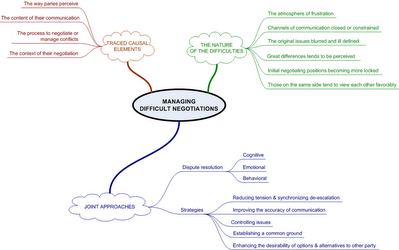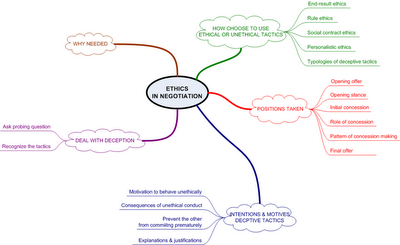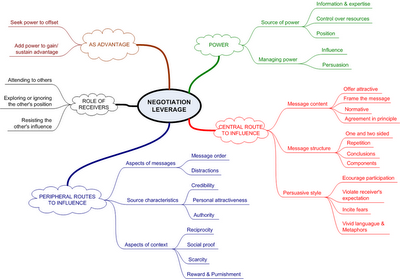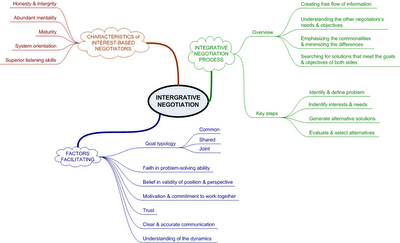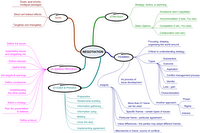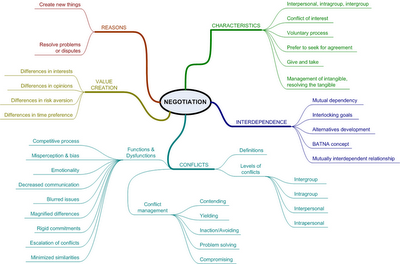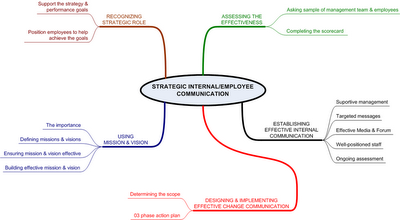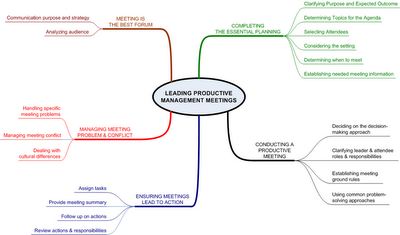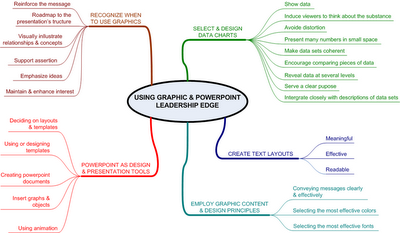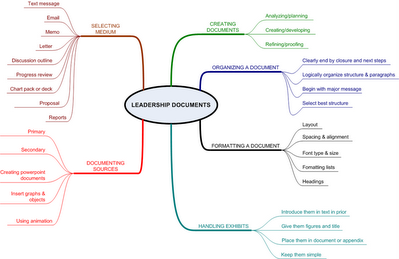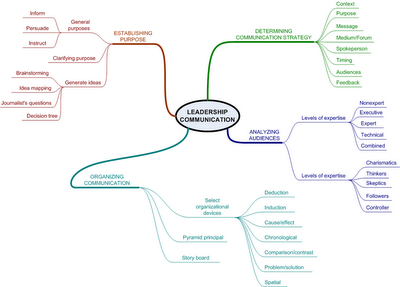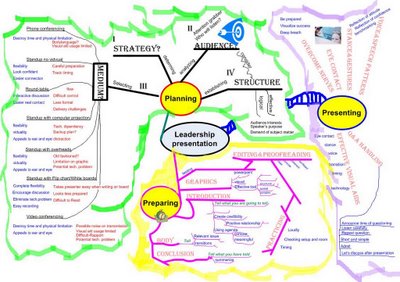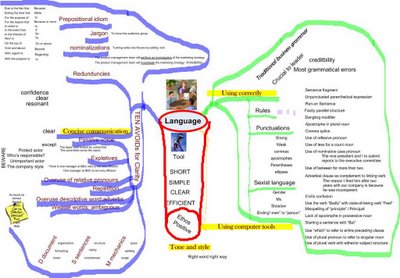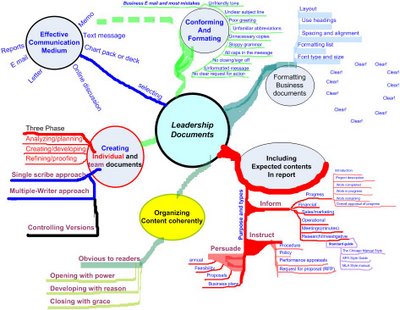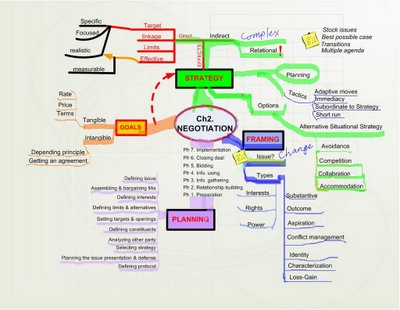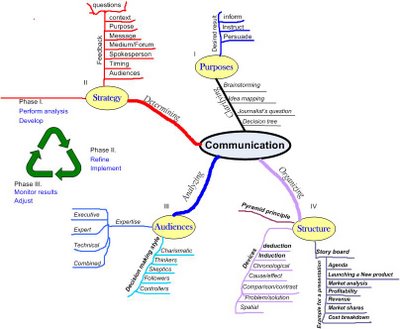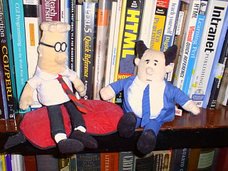Leadership Text Link:
http://highered.mcgraw-hill.com/sites/0073403148/information_center_view0/
Monday, September 03, 2007
Saturday, November 04, 2006
Negotiation and Organizational Cultures
Negotiation in Business Cultures Organizational Cultures
Research by Inna
The conduct of business negotiations can be compared to diplomacy between nation states. Not only do you need to understand the psychological make-up of the main negotiators, the national culture if the negotiation is cross-border, but you also need to understand the organizational culture of the company or organization you are negotiating with.
Organizations are rather like tribes, they have their own myths and legends. Michael S Malone, in Infinite Loop, argues that the history of Apple Corporation reflected the influence of Steve Jobs and Steve Wozniak. Malone starts Infinite Loop with the statement that "Before and after everything, companies are about character. Before the first idea, the first money, the first employees, the first distributor, retailer and customer, before the creation of the company itself, there is the character of the founders". This pattern can be seen in a number of companies; Microsoft, Intel, De Beers, Hewlett-Packard. Ford is still dominated by the Ford family; a pattern of family influence that is common in many continental European firms. Some corporations are dominated by the dominant idea of their worth and function; quality may be the dominate driver, attention to the welfare of the employees, to the increase of shareholder value, domination of a sector, or to some other goal that has been defined and accepted within the organization.
Anyone dealing with a company must have some concept and understanding of its value-system and culture. Strengths and weaknesses. Organizational cultures can empower organizations to achieve success after success, to sustain industry leadership over long periods and to create an attitude within the organization that everything is possible. Examples of positive organizational cultures can also be found in successful sports teams, such as New Zealand's "All Blacks" rugby team. However for the negotiator it is as important to understand the negative effects of culture, especially when organizations do not behave in a logical manner and exhibit resistance to new ideas. This can make life very difficult for the negotiator trying to secure agreement on a joint venture, or where the agreement requires a change in the behavior of the other organization (I am assuming that your own organization is perfect).
Every so often you meet a stone wall, a complete refusal to consider a set of ideas. It can be difficult to find a way round such road blocks. Such attitudes are not always due to stupidity, narrow-mindedness, or other mental weakness. Below we examine some of the issues which may be causing the problem. In dealing with such altitudes a head to head fight is rarely the best approach, something along the lines of "you are out of your skull", does not normally win the argument, even if you believe it. You should ideally find a way of attaching the idea to some aspect of the corporate culture, or precedent which the organization has adopted; in the same way that lawyers may claim to be following precedent when they are actually changing the law.
Irrational BehaviorOrganizational behavior is not always rational; the career path within the organization or the retention of out of date norms may cause an organization to behave in a manner which seems illogical and counter to the real interests of the organization.
If a potential business partner has an organizational culture which is negative or differs fundamentally from that of your organization then the likelihood of a successful long-term relationship developing is not strong.
Mindlessness
In The Knowing-Doing Gap by Jeffrey Pfeffer and Robert I. Sutton the authors note that "At its best, doing things in the same way provides continuity and helps define and establish an organization's culture and values. Culture and values, by definition, require substantial continuity over time" (page 75). But the authors also argue that business cultures can lead to the dominance of precedent, which makes it difficult to accept new ideas, as it may interfere with learning and the application of new knowledge. They say that, "Perhaps the most serious problem with precedent is that it is used automatically, almost without thought" (page 77). This behavior is known as "habits of mind", "programmed behavior", "automatic processing" or "mindlessness".
Ellen Langer in "Minding Matters" (in Advances in Experimental Social Psychology 1989, editor - Leonard Berkowitz) noted that an individual operating in such a mode, "becomes mindlessly trapped by categories that were previously created when the person was in a mindful mode" (page 137). See also Ellen J. Langer's Mindfulness and her The Power of Mindful Learning.
Rigidity
Jeffrey Pfeffer and Robert I. Sutton also make the point in The Knowing-Doing Gap that organizational rigidity can be a reaction to the threat of change. They refer to the creation of the Saturn car division by GM, and the subsequent failure of GM to learn from the experience, but they note that Saturn's own culture was also so strong that it also resisted change. Human beings also seek permanence and cling to "certainties" long after they have changed, change can be uncomfortable and threatening, it requires thinking about new concepts and may undermine an individual's established knowledge (there are still a few managers who are content to let others use the Internet).
For the negotiator "rigidity" in the other side may be a problem and an opportunity; the other side may stonewall some moves, but their rigidity may blind them to opportunities for their organization. They may literally be unable to "see" some things. Salesmen selling older technologies have benefited for years from the reluctance of their customers to grasp the benefit of newer solutions. Government Bureaucracies Additional examples of organizational programmed behavior can be found in Government bureaucracies where political policies and imbedded career structures may make preservation of an established order more important than adaptation to change.
Cultural problems with change
Organizations which have experienced major problems with the adoption of technology include financial institutions and legal partnerships. Sometimes the problems are arisen because of the failure on the part of supplier to offer appropriate solutions, but the problems often arise because of difficulties with communication; failures to express the real requirements and to understand what organizational changes are required in order to use new technology effectively.
The negotiator when arranging the deal should be aware of the existence of possible problems and will normally attempt to build mechanisms into the agreement which facilitate improved communications between the parties and clarity of specification definition.
Research by Inna
Research by Inna
The conduct of business negotiations can be compared to diplomacy between nation states. Not only do you need to understand the psychological make-up of the main negotiators, the national culture if the negotiation is cross-border, but you also need to understand the organizational culture of the company or organization you are negotiating with.
Organizations are rather like tribes, they have their own myths and legends. Michael S Malone, in Infinite Loop, argues that the history of Apple Corporation reflected the influence of Steve Jobs and Steve Wozniak. Malone starts Infinite Loop with the statement that "Before and after everything, companies are about character. Before the first idea, the first money, the first employees, the first distributor, retailer and customer, before the creation of the company itself, there is the character of the founders". This pattern can be seen in a number of companies; Microsoft, Intel, De Beers, Hewlett-Packard. Ford is still dominated by the Ford family; a pattern of family influence that is common in many continental European firms. Some corporations are dominated by the dominant idea of their worth and function; quality may be the dominate driver, attention to the welfare of the employees, to the increase of shareholder value, domination of a sector, or to some other goal that has been defined and accepted within the organization.
Anyone dealing with a company must have some concept and understanding of its value-system and culture. Strengths and weaknesses. Organizational cultures can empower organizations to achieve success after success, to sustain industry leadership over long periods and to create an attitude within the organization that everything is possible. Examples of positive organizational cultures can also be found in successful sports teams, such as New Zealand's "All Blacks" rugby team. However for the negotiator it is as important to understand the negative effects of culture, especially when organizations do not behave in a logical manner and exhibit resistance to new ideas. This can make life very difficult for the negotiator trying to secure agreement on a joint venture, or where the agreement requires a change in the behavior of the other organization (I am assuming that your own organization is perfect).
Every so often you meet a stone wall, a complete refusal to consider a set of ideas. It can be difficult to find a way round such road blocks. Such attitudes are not always due to stupidity, narrow-mindedness, or other mental weakness. Below we examine some of the issues which may be causing the problem. In dealing with such altitudes a head to head fight is rarely the best approach, something along the lines of "you are out of your skull", does not normally win the argument, even if you believe it. You should ideally find a way of attaching the idea to some aspect of the corporate culture, or precedent which the organization has adopted; in the same way that lawyers may claim to be following precedent when they are actually changing the law.
Irrational BehaviorOrganizational behavior is not always rational; the career path within the organization or the retention of out of date norms may cause an organization to behave in a manner which seems illogical and counter to the real interests of the organization.
If a potential business partner has an organizational culture which is negative or differs fundamentally from that of your organization then the likelihood of a successful long-term relationship developing is not strong.
Mindlessness
In The Knowing-Doing Gap by Jeffrey Pfeffer and Robert I. Sutton the authors note that "At its best, doing things in the same way provides continuity and helps define and establish an organization's culture and values. Culture and values, by definition, require substantial continuity over time" (page 75). But the authors also argue that business cultures can lead to the dominance of precedent, which makes it difficult to accept new ideas, as it may interfere with learning and the application of new knowledge. They say that, "Perhaps the most serious problem with precedent is that it is used automatically, almost without thought" (page 77). This behavior is known as "habits of mind", "programmed behavior", "automatic processing" or "mindlessness".
Ellen Langer in "Minding Matters" (in Advances in Experimental Social Psychology 1989, editor - Leonard Berkowitz) noted that an individual operating in such a mode, "becomes mindlessly trapped by categories that were previously created when the person was in a mindful mode" (page 137). See also Ellen J. Langer's Mindfulness and her The Power of Mindful Learning.
Rigidity
Jeffrey Pfeffer and Robert I. Sutton also make the point in The Knowing-Doing Gap that organizational rigidity can be a reaction to the threat of change. They refer to the creation of the Saturn car division by GM, and the subsequent failure of GM to learn from the experience, but they note that Saturn's own culture was also so strong that it also resisted change. Human beings also seek permanence and cling to "certainties" long after they have changed, change can be uncomfortable and threatening, it requires thinking about new concepts and may undermine an individual's established knowledge (there are still a few managers who are content to let others use the Internet).
For the negotiator "rigidity" in the other side may be a problem and an opportunity; the other side may stonewall some moves, but their rigidity may blind them to opportunities for their organization. They may literally be unable to "see" some things. Salesmen selling older technologies have benefited for years from the reluctance of their customers to grasp the benefit of newer solutions. Government Bureaucracies Additional examples of organizational programmed behavior can be found in Government bureaucracies where political policies and imbedded career structures may make preservation of an established order more important than adaptation to change.
Cultural problems with change
Organizations which have experienced major problems with the adoption of technology include financial institutions and legal partnerships. Sometimes the problems are arisen because of the failure on the part of supplier to offer appropriate solutions, but the problems often arise because of difficulties with communication; failures to express the real requirements and to understand what organizational changes are required in order to use new technology effectively.
The negotiator when arranging the deal should be aware of the existence of possible problems and will normally attempt to build mechanisms into the agreement which facilitate improved communications between the parties and clarity of specification definition.
Research by Inna
Welcome
Welcome to Doc Syl's cumulative site for Business Communication/Communication in Leadership and Negotiation.
Subscribe to:
Posts (Atom)
